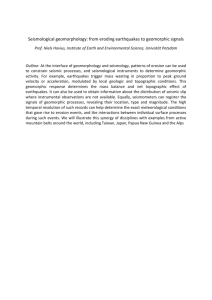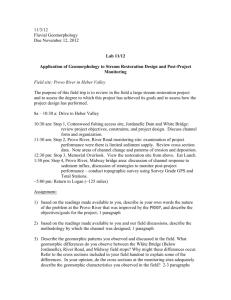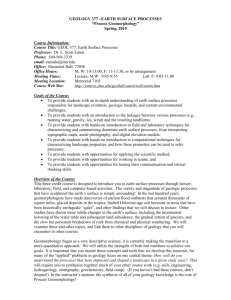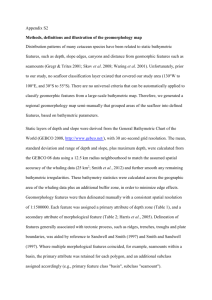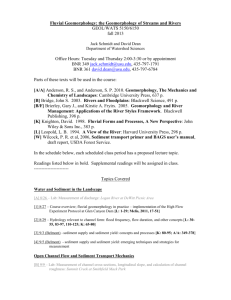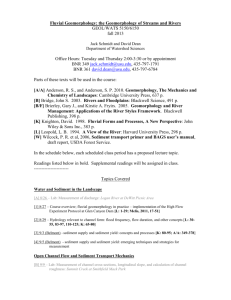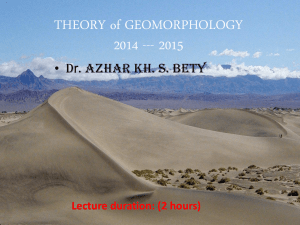GEOG 101: Principles of Physical Geography
advertisement
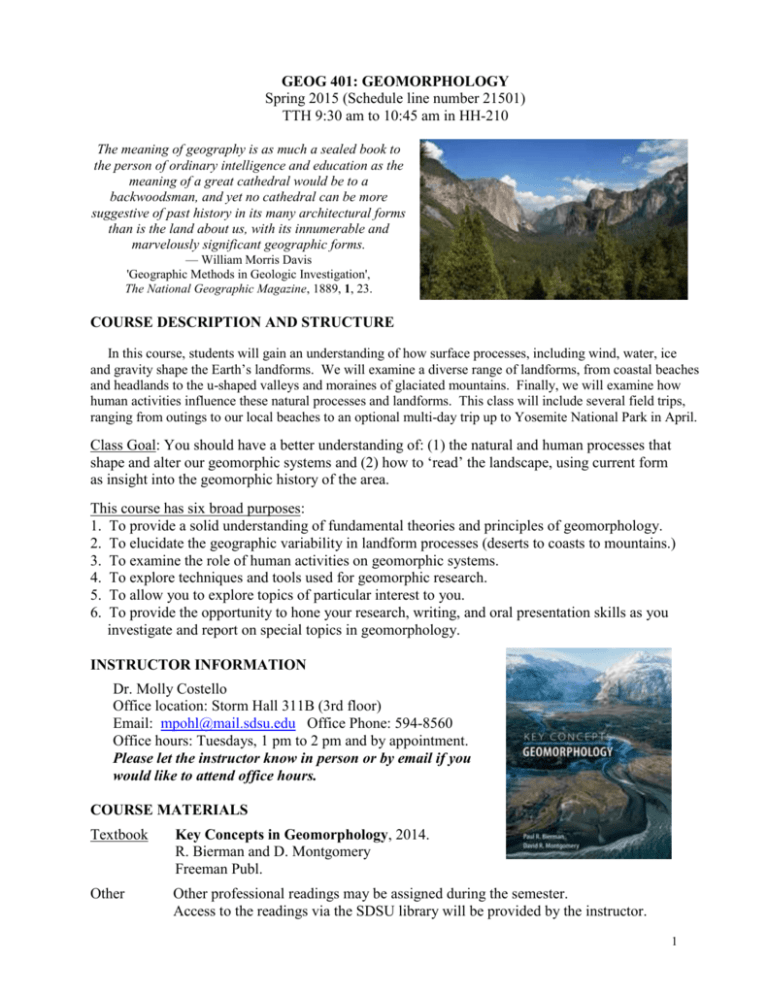
GEOG 401: GEOMORPHOLOGY Spring 2015 (Schedule line number 21501) TTH 9:30 am to 10:45 am in HH-210 The meaning of geography is as much a sealed book to the person of ordinary intelligence and education as the meaning of a great cathedral would be to a backwoodsman, and yet no cathedral can be more suggestive of past history in its many architectural forms than is the land about us, with its innumerable and marvelously significant geographic forms. — William Morris Davis 'Geographic Methods in Geologic Investigation', The National Geographic Magazine, 1889, 1, 23. COURSE DESCRIPTION AND STRUCTURE In this course, students will gain an understanding of how surface processes, including wind, water, ice and gravity shape the Earth’s landforms. We will examine a diverse range of landforms, from coastal beaches and headlands to the u-shaped valleys and moraines of glaciated mountains. Finally, we will examine how human activities influence these natural processes and landforms. This class will include several field trips, ranging from outings to our local beaches to an optional multi-day trip up to Yosemite National Park in April. Class Goal: You should have a better understanding of: (1) the natural and human processes that shape and alter our geomorphic systems and (2) how to ‘read’ the landscape, using current form as insight into the geomorphic history of the area. This course has six broad purposes: 1. To provide a solid understanding of fundamental theories and principles of geomorphology. 2. To elucidate the geographic variability in landform processes (deserts to coasts to mountains.) 3. To examine the role of human activities on geomorphic systems. 4. To explore techniques and tools used for geomorphic research. 5. To allow you to explore topics of particular interest to you. 6. To provide the opportunity to hone your research, writing, and oral presentation skills as you investigate and report on special topics in geomorphology. INSTRUCTOR INFORMATION Dr. Molly Costello Office location: Storm Hall 311B (3rd floor) Email: mpohl@mail.sdsu.edu Office Phone: 594-8560 Office hours: Tuesdays, 1 pm to 2 pm and by appointment. Please let the instructor know in person or by email if you would like to attend office hours. COURSE MATERIALS Textbook Key Concepts in Geomorphology, 2014. R. Bierman and D. Montgomery Freeman Publ. Other Other professional readings may be assigned during the semester. Access to the readings via the SDSU library will be provided by the instructor. 1 GRADES AND ASSIGNMENTS Grades will be based on a straight scale: ≥90% = A, 80-89.9% = B, 70-79.9% = C, 60-69.9% = C, <60% = F The grades in this course will be calculated as follows: Assessment (60%) Three quizzes at 20% each (Feb. 19, Mar. 24 and May 5) Assignments and Research Paper (40%) Research Paper 20% Assignments and Field Trips 20% Assessment: Quiz #1 (20%) and Quiz #2 (20%) and Quiz #3 (20%) Quizzes will be comprised of short answer and essay questions that test your knowledge of geomorphology, your ability to ‘read’ the landscape, and your capability in applying this understanding towards addressing geomorphic problems. Assignments and Research Paper (40%) 1. Research Paper (20%) Each student in this course will have a different interest in geomorphology and deserves to explore that topic. Perhaps you are interested in San Diego beach erosion and its impacts on recreation or habitat. Perhaps want to explore the impact of Tijuana River watershed activities on river flooding and landforms. The final project is an opportunity for you to investigate a specific geomorphic problem of your choice, analyze the information you collect, and provide your assessment of how to mitigate the problem. The paper should be 7-8 pages, typed, double-spaced (not including figures, tables, or references). With rare exceptions, primary references should be from professional literature and sources. Papers should be organized following standard APA format (see details & view tutorial at http://www.apastyle.org/) The 20% will be distributed as follows: 5% for phase 1 (research question, introduction, outline and references), and 15% for the final paper. More details will be provided early in the semester. 2. Assignments and Field Trips (20%) There will be a number of small, take-home (or in-class) reading responses and practical exercises given throughout the semester. These are opportunities to test your comprehension and assess whether you can perform a calculation or analysis, all of which benefit test scores and overall class understanding. Part of this score is also for attending field trips or completing the required replacement assignments (see details under “field trips” on the following page). Most assignments will be given in class as we get to the relevant materials. The Current Issues in Geomorphology assignment is provided below. Current Issues in Geomorphology (due 4/14) Over the course of the semester, you will collect three articles from current news (e.g. CNN, NY Times, SD Union-Tribune) that are relevant to geomorphology (e.g. articles on landslides, floods or beaches). Provide one page of analysis for each article, using what you have learned in class to explain the geomorphic problem or situation. What happened? Why? What role did human activities play, if any? Was this event avoidable? Desirable? What possible future science or management issues arise from this event? An example of what the final product should look like will be available on Blackboard for you to review prior to completing this assignment. The goal is for you to see that: (1) every day around the world geomorphological events are shaping our lives and (2) you can use the knowledge that you gain in this class to better understand what is happening and why it is happening. 2 FIELD TRIPS Field trips offer important opportunities to use your knowledge and skills in a real-world context. Calculations, theories, and principles have more meaning when you are applying them on the landscape. In addition, you are limited in terms of how well you can truly understand landforms in a classroom. Thus, I highly encourage participation in field trips as a means to gain more from this class experience. If you do not attend, you will be given a replacement assignment selected by the instructor. Missing a field trip or replacement assignment will result in the loss of points for the semester. Our class field trips for this semester are as follows: San Diego Geomorphology Overview / Coastal Geomorphology Saturday, Jan. 31 (12:30 pm to 3:30 pm) We will meet at Torrey Pines State Park to provide a geomorphic overview of San Diego as a means to introduce students to the course. In addition, we will study the coastal geomorphology of the area and evaluate the ‘winter beach’ conditions at Torrey Pines. The time is set to correspond to low tide, allowing for the best geomorphic viewing and coastal access. Further details provided prior to the field trip. Arid Lands Geomorphology: Wind, Water, Geologic Controls Saturday, March 21 (9 am to 5 pm; optional overnight) This all day excursion to Anza-Borrego Desert State Park allows us to explore the geomorphology of arid lands and the importance of geologic controls to geomorphic processes. We will look back through geologic time, explore the history of the basin, and investigate past and current geomorphic processes. Yosemite National Park: Glacial and Fluvial Processes and Mass Movements Thursday, April 16 to Sunday, April 19 This four day trip is a highlight of this course. In addition to its stunning beauty, Yosemite National Park is an ideal place to examine glacial and fluvial processes, as well as mass movements. Contemporary processes, including recent rock falls and major floods, overlie a landscape shaped by recent Pleistocene glaciations. We will explore the valley and discuss the current and past geomorphic processes shaping Yosemite. In addition, we will look at human-landscape interactions and how the National Park Service is trying to balance the difficult charge to both protect the resources of the park and allow for access and appreciation of its beauty. Costs for this field trip (bus transport and camping fees) will be discussed the first week of class. 3 TENTATIVE COURSE OUTLINE DATES Jan 22 Jan 27 Jan 29 Sat., Jan. 31 Feb. 3 and 5 Feb. 10 and 12 Feb. 17 and 19 Feb. 24 and 26 Mar. 3 and 5 Mar. 10 and 12 Mar. 17 and 19 Sat., Mar. 21 Mar. 24 and 26 April 7 and 9 April 14 Apr. 16 to 19 April 21 and 23 Apr. 28 and 30 May 5 May 7 TOPIC Class Structure and Organization; Intro to Course Earth’s Dynamic Surface Geomorphologist’s Tool Kit San Diego Geomorphology Overview / Coastal Geomorph 12:30 pm to 3:30 pm: Torrey Pines State Park (note that Sunday, Feb. 1, same time, is weather backup) Weathering and Soils Geomorphic Hydrology Geomorphic Hydrology cont. QUIZ 1 on Thursday, Feb. 19 Research Process and Term Papers Hillslopes Channels Drainage Basins Wind as a Geomorphic Agent Arid Lands Geomorphology Field Trip 9 am to 5 pm: Anza-Borrego Desert State Park With optional overnight camping QUIZ 2 on Tuesday, March 24 Thurs: Yosemite Field Trip Guidebook/Early Preparation Spring Break at SDSU – March 30 to April 4 Glacial and Periglacial Geomorphology Research Introduction due 4/9 Glacial History of Yosemite Field Trip Preparation Current Issues in Geomorphology due 4/14 Yosemite National Park Field Trip Must preregister and pay for trip through Aztec Adventures Coastal Geomorphology Volcanic Geomorphology QUIZ 3 on Tuesday, May 5 Course Synthesis and Conclusions Research Papers due May 7 READINGS Chapter 1 Chapter 2 Chapter 3 Chapter 4 Chapter 5 Chapter 6 Chapter 7 Chapter 10 tbd Chapter 9 tbd Chapter 8 Chapter 11 Important note: This syllabus is subject to modification. All changes will be announced in class and on the Blackboard site for this course. You are responsible for being aware of any adjustments. Please contact your instructor if you have any questions about adjustments course timing or content. 4 GENERAL CLASS INFORMATION AND POLICIES 1. Blackboard: This class is supported by Blackboard. Please access Blackboard for your syllabus, assignments, announcements and other class-related items. 2. Late Work: No late assignments are accepted and no make-up exams are given without prior arrangement with the instructor. The grade of any work handed in late, including homework and papers, will be deducted 10% for each day late. Excused late work is granted in only extraordinary circumstances of illness or emergencies. 3. Attendance: Attendance is not mandatory, but is highly encouraged since a much better understanding of course material arises from attending lecture. Correspondingly, grades are higher for students with good attendance. 4. Help and Feedback: Office hours are intended to provide individual help, discuss problems or interests, provide comments about the course, or just to get acquainted. I am more than happy to work with you during these times or, if my office hours conflict with your schedule, at other times. Please don’t miss out on getting help because you are reluctant to ask for it. Finally, I would appreciate if you make an appointment to meet with me via email or in person even during office hours so that I can ensure that I am available and not meeting with other students when you arrive. 5. Special Student Circumstances: If you have special circumstances (e.g. disabilities, sports schedule conflicts, foreign language student, or course forgiveness student) please meet with the instructor at the beginning of the course to discuss your situation. 6. Disabilities: If you are a student with a disability and believe you will need accommodations for this class, it is your responsibility to contact Student Disability Services (SDS) at (619) 594-6473. To avoid any delay in the receipt of your accommodations, you should contact Student Disability Services as soon as possible. Please note that accommodations are not retroactive, and that I cannot provide accommodations based upon disability until I have received an accommodation letter from Student Disability Services. Your cooperation is appreciated. The SDS website is http://go.sdsu.edu/student_affairs/sds/ 7. Academic Integrity is one of the fundamental principles of a university community. SDSU expects the highest standards of academic honesty from all students. Violations of academic integrity include the following: (1) unauthorized assistance on an examination, (2) falsification or invention of data, (3) unauthorized collaboration on an academic exercise, (4) plagiarism, (5) misappropriation of research materials, (6) unauthorized access of an instructor’s files or computer account, and (7) any other serious violation of academic integrity as established by the instructor. If your academic integrity is not maintained on a test or assignment, you will automatically receive a grade of zero for that test or assignment and you will be reported to the Center for Student Rights and Responsibilities. Penalties can be severe. For more information on what constitutes plagiarism, please ask me or see this website: http://wps.prenhall.com/hss_understand_plagiarism_1/0,6622,427064-,00.html 5 Name__________________________________ Major______________________Yr_________ Background in geomorphology, geology, or physical geography Particular interest in geomorphology….if you have one. Describe what you see in these photos. Tell me their story. (Write to the left of the photo) Convict Lake area, Eastern Sierra Nevada San Simeon area, coastal CA 6
